 Despite the rise in real-time, tech-based controls designed to help businesses monitor foodborne illness risks, outbreaks continue to be an issue for foodservice operations. The CDC recorded 519 norovirus outbreaks between August 2023 and January of this year, a sharp rise from the previous year’s numbers, and Salmonella has impacted people across 32 states in recent months. On top of food safety technology that helps foodservice operations monitor protocols and stay alert to problems, old-fashioned food safety practices are just as important. A Food Safety Tech report says this should include thorough, frequent handwashing; proper hand hygiene prior to handling food; and the use of alcohol-based sanitizer as an added precaution – not a substitute – for handwashing. It’s also important to clean and sanitize high-touch surfaces and equipment regularly – and wash and sanitize produce to eliminate contaminants (the recent Salmonella outbreak was linked to cantaloupe and pre-cut fruit products). The report also advises careful handling and proper cooking of seafood, particularly shellfish, and having an employee policy with clear guidelines for managing staff illness, especially regarding when it’s important to avoid handling food or reporting to work. 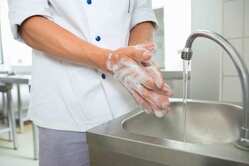 When the U.S. Centers for Disease Control (CDC) led a study investigating the various factors that contribute to the cross-contamination of food in restaurants, they found more frequent cases of contamination in businesses that were lacking food safety training and certification, as well as those without handwashing policies. Contamination risks were present in restaurants that didn’t require manager certification or train workers in food safety, for example. As for handwashing, the risk for contamination was greatest in restaurants that didn’t have policies detailing where, when and how often to wash hands, or on the need to minimize bare-hand contact with ready-to-eat foods. Unfortunately, 60 percent of the foodborne illness outbreaks reported to the CDC each year connect back to restaurants, so it’s worth zeroing in on these areas if improving food safety is on your list of priorities this year. Having a staff discussion about handwashing is something a restaurant manager can do right away to help lower a restaurant’s risks – particularly at a time when seasonal viruses are common. 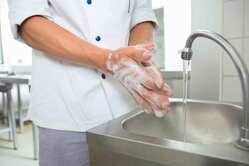 Approximately 48 million people in the U.S. – roughly one in six people – get sick, 128,000 are hospitalized, and 3,000 die each year from foodborne diseases, according to the Centers for Disease Control and Prevention. The financial impact following a single foodborne illness outbreak associated with a restaurant can run into the millions of dollars, not to mention the threats it poses to people’s lives. While these outbreaks are a significant problem, the good news is that they are largely preventable. As seasonal illnesses ramp up, do you feel your staff is focusing in the correct areas to limit the spread of infection? Prioritize the targets with the biggest protective potential – such as thorough handwashing on the job and labor scheduling to help ensure backup if and when staff are ill this winter. Your training can reinforce the “why” behind these precautions. 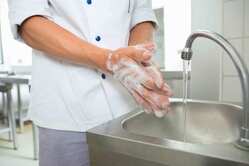 Poor hygiene is among the biggest contributors to the spread of foodborne illness – and it can make seasonal illnesses easier to spread too. Make sure your staff receive reminders about proper handwashing technique, as well as which sinks are to be used for handwashing. Beyond that, reinforce your policy around the use of protective items like gloves and hairnets, as well as jewelry – rings, bracelets and watches can all harbor bacteria and be potential sources of cross-contamination. Staff should keep their own drinks covered with a lid and confined to break rooms. 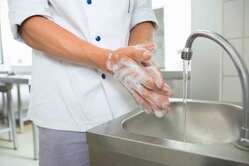 When it comes to protecting your guests from pathogens, maintaining proper hand hygiene is the most important thing your staff can do. The most common cause of foodborne illness is spreading pathogens through touch and food can become contaminated quickly if those preparing and serving your food don’t maintain adequate hygiene or use personal protective equipment incorrectly. Hand washing, in combination with protective gear like food-grade gloves, are your best defenses. According to the CDC, thorough hand washing requires wetting hands with clean running water; applying soap; lathering both sides of the hands, between fingers and under fingernails; scrubbing hands for at least 20 seconds; rinsing hands under clean running water; and drying them with a clean towel or air dryer. Does your staff do a thorough enough job? 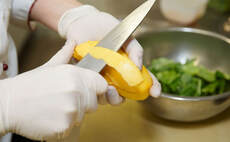 Bare-hand contact with ready-to-eat foods triggers about 30 percent of foodborne illnesses in restaurants each year, according to the CDC. In addition to following recommendations for frequent handwashing, using tongs, deli tissue or single-use gloves can provide a useful backstop protecting your restaurant’s food safety record. Just make sure staff follow proper procedures for using, cleaning, and where appropriate, discarding, these items so you can prevent cross-contamination and avoid having staff use these protections in place of regular handwashing. 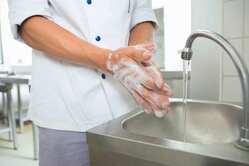 Hand hygiene plays a significant role in food safety – and the summer months can make it more important and more difficult to do frequently. Your staff may be serving guests in outdoor dining areas or pop-up stalls that take them farther away from handwashing sinks. They may be handling more surfaces when passing from outdoor to indoor air-conditioned spaces. Hot temperatures can cause busy staff to perspire. If the warmer weather brings a change in routine for your staff, consider how to build in handwashing breaks at regular intervals – and remind staff to wash hands for at least 20 seconds with soap and running water. 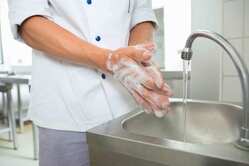 Frontline workers embody your restaurant’s food safety culture – but what they represent to the public isn’t always understood at the top of the business. A recent webinar from Food Safety Magazine indicated that senior leaders in an organization tend to rate their culture as 68 percent more mature than their frontline colleagues do. That’s even though frontline managers make up 60 percent of the workforce and manage 80 percent of it. To bridge the disconnect, experts on the webinar advised gentle nudges to steer frontline food safety in the right direction. These nudges could include physical markings on floors and walls, group handwashing stations that make activities like handwashing more social, daily routines in which staff must answer a food safety question or provide input and the supervisor responds with positive feedback or an action item they are taking as a result, social normative messages that provide feedback about the team’s overall knowledge about a particular area of food safety, or social recognition – like a time-off savings account that can be tapped by a team that wins a contest around food safety. 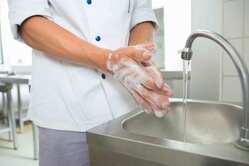 Little seems to spread more reliably than norovirus – or the fear of catching one. In a grab bag of seasonal illnesses, norovirus still stands out for its potential impact on businesses. According to a recent FDA study on norovirus prevention, excluding ill employees from the workplace had the biggest impact on consumer illnesses and also resulted in fewer norovirus cases. But the study also found that excluding ill employees was most effective when the business took extra precautions – such as increased handwashing in general, handwashing prior to the use of gloves, eliminating the need for employees to have hand contact with restroom surfaces, and improving the cleaning and sanitizing of restroom surfaces. Looking at these practices, is there room for your business to make changes? Doing so could help you dodge norovirus, along with other illnesses making the rounds this winter.  Is your message getting across when it comes to enforcing food safety practices in your restaurant? It may not be. Perhaps you have staff from a different culture who don’t yet have the English-language proficiency to fully understand your training as it is currently delivered. Even staff who don’t face a language barrier at work might have been raised with different views on whether a food is safe when kept unrefrigerated or when it is necessary to wash hands. Tasks that are perceived in different ways are likely to be completed differently as a result. Conducting ongoing training and, just as importantly, taking care to assume nothing about a person’s knowledge, can help you uncover surprising gaps in your food safety culture. |
subscribe to our newsletterArchives
April 2024
Categories
All
|



 RSS Feed
RSS Feed